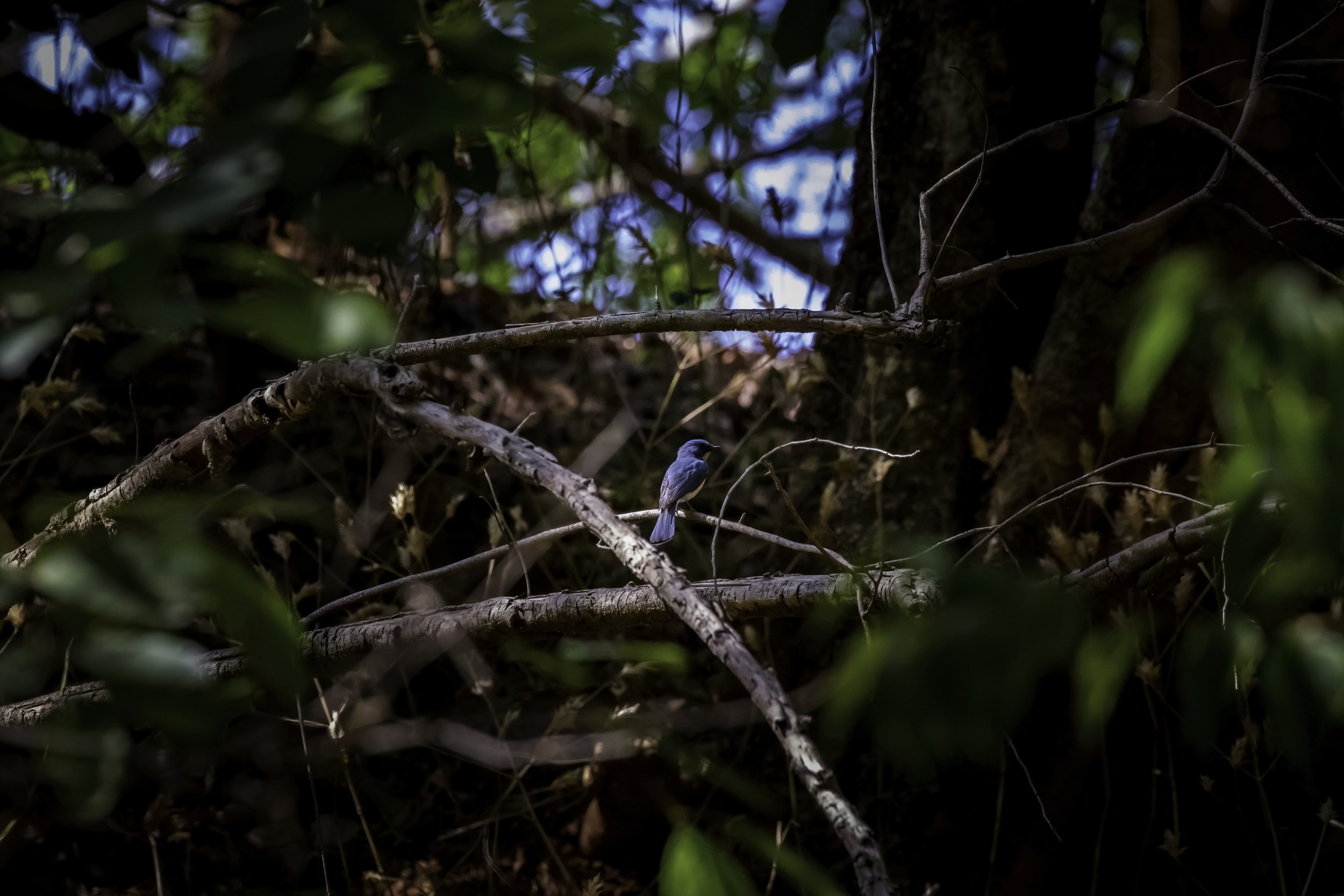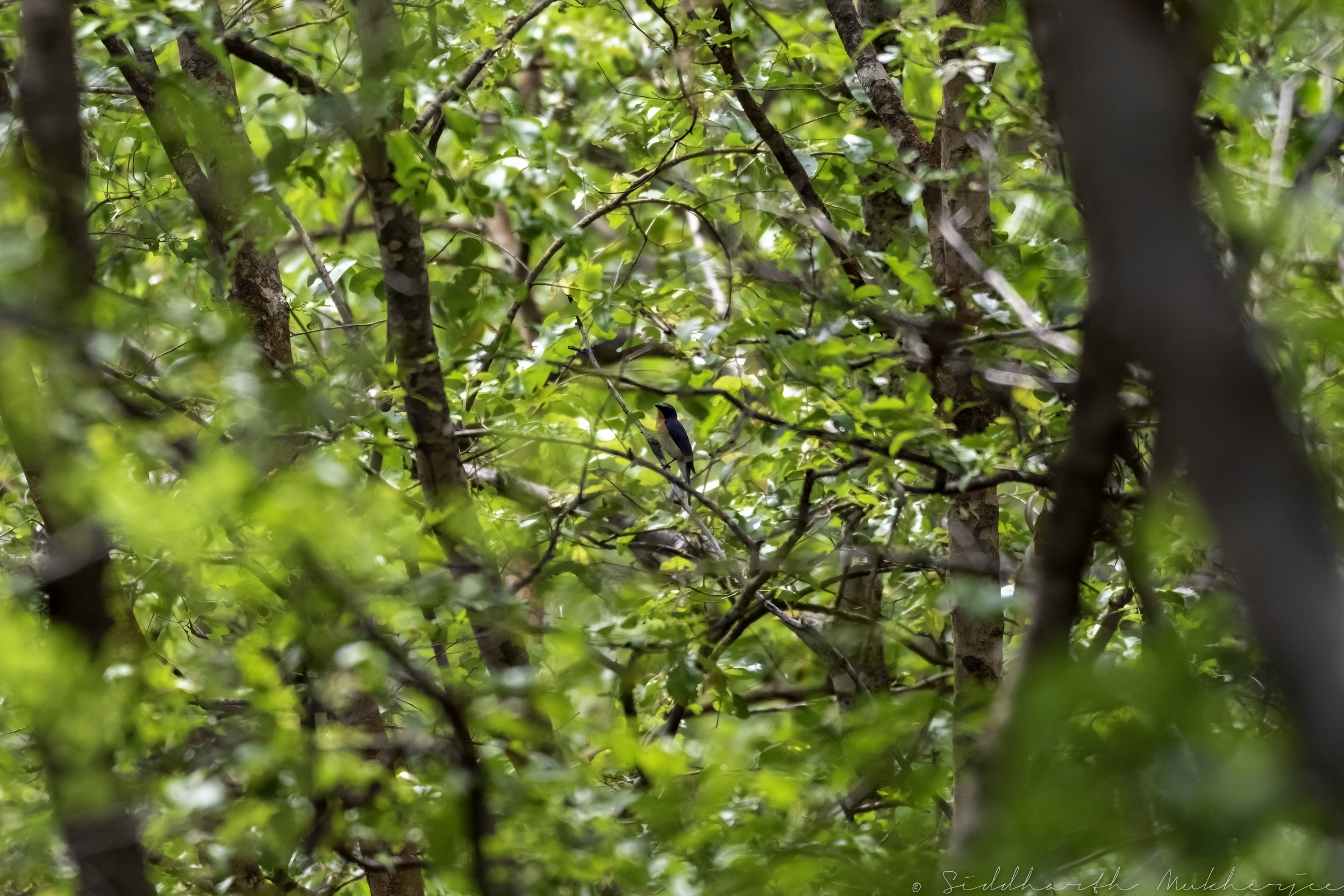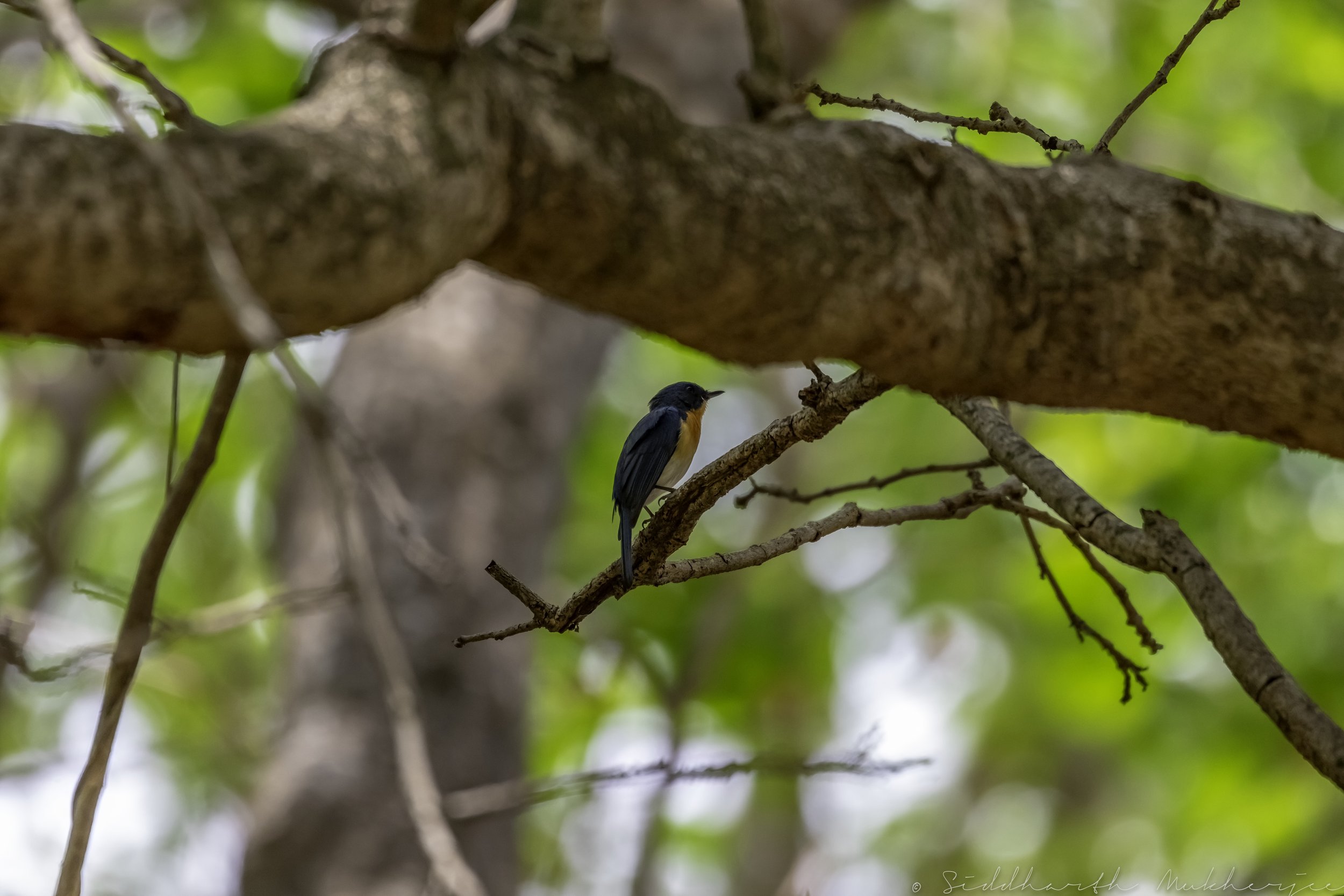Tickell’s Blue Flycatcher
Cyornis tickelliae
Kawal Tiger Reserve & forests all over Telangana
The Tickell’s Blue Flycatcher is an attractive medium-sized Old World Flycatcher with blue upperparts and orange-and-white underparts, with the most orange on the chest and the throat. The male Tickell’s Blue is more intensely-coloured overall than the female. Its smaller-billed profile, less extensive orange, and paler face distinguish this species from male Hill-Blue Flycatcher. The extensive orange on the throat separates the Tickell’s Blue from the Blue-throated Flycatcher. It favours open hill forests as well as forest edges, particularly in drier, scrubby areas, often close to water. Both sexes give a pleasant high-pitched tinkling song and their calls include dry rattles and metallic clinks.
Located in the central stretch of the Deccan Plateau, Telangana has sub-tropical climate and the terrain consists mostly of hills, mountain ranges, and thick dense forests covering an area of 27,292 km². The annual rainfall ranges between 1,100 mm to 1,200 mm and the annual temperature varies from 15 C to 45 C. The State is drained by a number of rivers which include the Godavari and the Krishna rivers.
Three National Parks and nine Wildlife Sanctuaries constitute the Protected Area network of the State covering 5.08% of its geographical area and our focus area today is the northern eastern part of the state and the Kawal Tiger Reserve. The Kawal Tiger Reserve lies within the Jannaram mandal of Adilabad district. The Government of India declared the Kawal Wildlife Sanctuary a Tiger Reserve in 2012 and HyTiCoS was a key influencer in this decision. At present the reserve has a low tiger density but promises tremendous potential as a source area with stepped up protection and habitat amelioration under Project Tiger. The Kawal Wildlife Sanctuary was established in 1965 and later declared as a Protected Area (PA) in 1999 under the WPA, 1972. Incidentally, when I went through my photographs over the years, I realized that a lot of the wild and birdlife I had photographed were from the areas in the Godavari River basin and its tributaries. Read about them here.
Kawal is well known for its abundant flora and fauna. The reserve is catchment for the rivers Godavari and Kadam, which flow towards the south of the sanctuary. The Kawal Tiger Reserve (KTR) is spread over a total area of 2015.44 km² of which the Core Area is 893 km² extending in the districts of Nirmal, Mancherial, Adilabad and Kumuram Bheem Asifabad. Geographically the reserve is situated in the southern-most tip of the Central Indian Tiger Landscape, having linkages with the Tadoba-Andhari (Maharashtra) and Indravati (Chhattisgarh) Tiger Reserve. Thus, the habitat has tremendous significance for tiger conservation in the region. It is also a major catchment of river Godavari and local rivulets like Peddavagu and Kadam. It is a typical central Indian Tiger Landscape having southern Tropical Dry Deciduous Forest. After being listed as a Tiger Reserve in April 2012, it was developed as a tiger habitat with the release of 150 Chital as the prey population and today it is home to Nilgai, Sambhar, Chausingha, Wild Boar, Wild Dogs, Gaur, Foxes, Wolves, Bats, Sloth Bear, Leopards & passing Tigers. The bird life too is abundant with a number of Peacocks, Bulbuls, Partridges, Quails, Flycatchers, Thrushes, Hawk-Cuckoos, Eagles, Vultures to name a few of the 242 bird species reported here. Read about some of them below. To reduce poaching, new check-posts have been created and traditional sources of water improved. HyTiCoS is also leading from the front conducting regular threat assessments and snare removal surveys, monitoring the Tigers which are in and passing through, conducting large-scale occupancy surveys and monitoring the prey base. They map corridors, conduct Bird Walks and Biodiversity Documentation Checklists and much more.
Read about the other flycatchers of Telangana:
Tickell’s Blue Flycatcher
The Tickell's Blue Flycatcher (Cyornis tickelliae) is a small passerine bird in the flycatcher family. This is an insectivorous species which breeds in tropical Asia, from the Indian Subcontinent eastwards to Bangladesh & western Myanmar. The Indochinese Blue Flycatcher was formerly considered conspecific. The Tickell’s Blue has blue on the upperparts and the throat and breast is rufous. They are found in dense scrub to forest habitats. The name commemorates the wife of the British ornithologist Samuel Tickell who collected in India and Burma.
The Tickell's Blue Flycatcher is about 11–12 cm long. It sits upright and forages mainly in the over growth. The male's upper parts are a bright blue, its throat and breast are orange, and the rest of the underparts are white. The female is a duller blue with a brighter blue brow, shoulder, rump, and tail. It hybridizes with the Pale-chinned Blue Flycatcher (Cyornis poliogenys) in the Eastern Ghats of India and these hybrids have sometimes been treated as a subspecies vernayi. The juvenile is streaked and has a spotted mantle, scaly brown upperparts, head and breast, with just the wings and tail being blue. They have sometimes been known to feed even after dusk. Apart from flying insects they may occasionally pick up crawling insects.
The species shows regional variations in plumage and size and several of these populations have been designated with subspecies names. The nominate form is found in India, Nepal and Myanmar. The Sri Lankan population is separated as jerdoni (or nesea/mesaea said to be darker) has a longer bill. C. t. indochina extends in range from Myanmar, through Thailand into Cambodia and Vietnam. Southern Thailand, peninsular Malaysia and northeast Sumatra has the population C. t. sumatrensis while lamprus is an insular population on Anamba Island. In the past this species has been considered as a subspecies of the Blue-throated Blue Flycatcher (Cyornis rubeculoides) which resembles this but has a blue throat.
The Tickell’s Blue Flycatcher is about 14-15 cm long and weighs between 12-18 grams. It is a medium sized blue or paler blue-gray flycatcher with orange & white lower parts. Mates of the nominate breed has the upper part of the forehead up to above the eye sky blue, the lower part of the forehead to the cheeks, the lower ear blankets and a blackish blue chin. The rest of the head and upper parts, including the upper wings and tail are a ceruleo blue, the lower blankets are also bright blue (forming the "shoulder stain"); center of the lower part of the throat to the upper part of the orange-ruff chest (sometimes paler in the throat), often quite delimited from the white of the belly, flanks and under caudal blankets, but sometimes there is an orange wash on the flanks. The iris is brown with a black beak and bluish brown to purplish gray, pink or pink brown legs. It is distinguished from Javan Blue Flycatcher (Cyornis banyumas) mainly by the smaller beak, the shorter primary projection, the head and upper parts of lighter blue colour (the blue extends narrowly to the chin), the dark colour of the lores not so black and not reaching the auricular covers, the lower orange generally less extensive. It differs from the Blue-throated Blue Flycatcher (Cyornis rubeculoides) by the head and the upper parts of paler blue colour, the demarcation generally sharp between the orange-rufous of the throat and the upper part of the chest and the white in the rest of the lower parts. The female is paler than the male, paler blue or ash gray above or slightly bluer on the rump and tail and brighter blue on the top of the forehead up to the eye and shoulder spot. It has pale orange on the upper lores to the partial edge of the eye, and orange below paler and often confined to a wash on the chest and flanks. The juvenile is dark brown above, with small specks or bay-coloured streaks on the crown, larger spots on the mantle and scapulars, wings and tail like the adult but with pale bay-coloured tips in the middle and upper part of the alar covers, finely veined or spotted with brown and bay face, narrow eye of bay colour, lores and chin generally pale bay colour, becoming slightly barred with warm brown on the chest, bay on the lower chest and flanks, and whitish on the under caudal blankets. The jerdoni breed has a longer beak than the nominal, the upper parts more intense ultramar blue and the orange of the chest extends to the belly and flanks and less delimited from white in the rest of the lower parts (in both sexes), some females have the orange-beige chest only on the chest, with the belly and flanks paler or washed orange.
The following sub-species are recognized:
Cyornis tickelliae tickelliae: Distributed in Southern Nepal and North, Central and South India; non-reproductive extends widely through the plains of India.
Cyornis tickelliae jerdoni: Distributed in Sri Lanka
Hybridization - Hybrid and Media Records in eBird
Pale-chinned x Tickell's Blue Flycatcher (hybrid) Cyornis poliogenys x tickelliae
The Tickell’s Blue Flycatcher lives in open, dry lowland and undermount forests and groves, including secondary forests, edges, groves, abandoned plantations, crop edges, villages and large tree gardens, bamboo, thickets and shrubs along streams. Lowlands up to 1,500 m in India, where in the non-reproductive season it is found in similar habitats throughout the plain. In Sri Lanka it resides along rivers and lakes in lowlands and hills, up to 1300 m. It is a resident bird with some localized movements. Birds from the North of India disperse towards the South in the plains between October and May. They are a rare winter visitor in Bangladesh. Presumably this species (instead of Cyornis sumatrensis) is wandering in the Andaman Islands (March 2004).
Little is known of their diet, but includes small invertebrates and larvae. They have also been recorded eating a small frog (Pseudophilautus sp.) in Sri Lanka. They are usually solitary or in pairs, as you can see in the photo above & in the photo gallery below, and can be seen occasionally in flocks of mixed species in dry forests. It can usually be seen perched upright, shaking the tail, often simultaneously emitting a high-pitched call. They actively look for food in the low to mid-forest levels, also in the undergrowth along the banks of the streams and around the bushes. They are often more active at sunrise and towards sunset. Most of the prey is caught by hunting or chasing them in jump flight; occasionally it hovers to pick them up from the foliage. Interestingly there is a couple where I live and like clockwork I can hear them calling outside my window starting 4am every morning.
They sing throughout the year with most of the singing in April and May, for both sexes. The song is usually a series of fast jingling notes that randomly change tone without a clear tendency, the typical phrases have c. 10 notes. The song of the Sri Lankan (jerdoni) race is more varied and includes short trills and respike notes. Calls include hard “tac“ and also a sharp “churr“.
Reproduction season is between April-August in most of the distribution area and between March-June in Sri Lanka. The Tickell’s is a territorial bird and the exhibitionist male leans to the side and lifts the crest and feathers of the back while making them vibrate, also partially fanning and extending the tail. The nest is in the shape of an open crown, of not very rigid construction, mainly of moss, grass, vegetable fibers and bamboo and other leaves, located at a height of up to 2 m from the ground in a crack of a rocky wall, between rocks, in the trunk of a tree or between the roots of a dumped tree. They lay 3-4 eggs and both parents take care of the chicks. There is no information on the duration of incubation and the nesting periods.
The Tickell’s Blue is not globally threatened but there is cause for concern (Minor Worry). They are locally common in India, but are a scarce resident or possibly only a winter visitor in the lowlands of Nepal; common in Sri Lanka. The size of the population of this species is unknown, but since there are no signs of decrease, it is believed that it is stable. No substantial threats have been identified.
‡‡‡‡‡
For a print of the beautiful birds from my various sojourns click on the button below to read my process and order a limited edition canvas.
‡‡‡‡‡
Related Posts







































